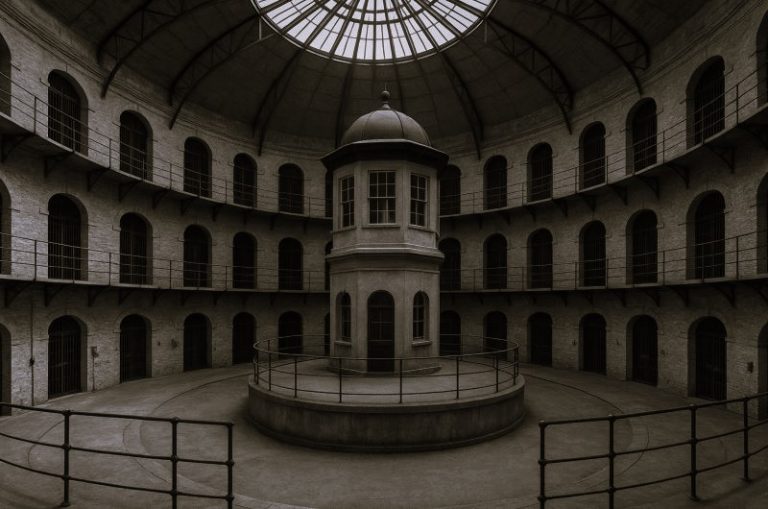

The Gallera or women’s prison was devised in the 17th century.

By Dr. D. José Luis de las Heras Santos
Professor of History
University of Salamanca
Abstract
The development of absolute monarchies and the appearance of different social dynamics from those of medieval times at the end of the 15th century and the beginning of the 16th century favoured the appearance of new penalisation. As far as women were concerned the new penalisation was limited initially to establishing separate prison accommodation for men and women. The intention was to avoid sins of the flesh without mention of the existence of a greater reformatory interest. From the 16th century and particularly after the Council of Trento, “Casas de Recogidas” (Women’s Reformatories) appeared in the main cities that were concerned with receiving and reforming women of “bad repute”. Initially these institutions held women whose arrival was apparently voluntary. The publication in 1608 of Magdalena de San Jerónimo’s Razón y Forma de Galera (prison purpose and design) provoked the construction of women’s prisons with clearly reformatory purposes. The criminalisation of women for reformatory purposes was prior to that of men. We have paid special attention to the case study of Salamanca within the wide network of Spanish cities that had establishments of this type. For this study we have used the documentation of the archives of the Cathedral of Salamanca and the Diocesan of Salamanca.
Introduction
In the old regime, sin and delinquency were considered to be very similar. In fact the gravity of crimes were derived from their seriousness in terms of sins. The throne and the church followed identical objectives: the defence of a society in which good and bad were defined in terms of the moral principles of Catholicism.
With respect to the correction of deviant conduct there was a distinct and discriminatory treatment for men and women. Men were directly responsible for their actions and responded for them before the judiciary but women were also made responsible for the influence of their behaviour on public morality. The Church put special emphasis on the erradication of what were then called public sins, which in general was behaviour which caused social scandal. This could be of a diverse nature and, in principle could be committed by men and women. In this category were crime-sins such as usury and blasphemy that were generally committed by men but more often the expression alluded to extramarital affairs and in this case women were under the obligation to neither sin nor encourage men to do so.
In the erradication of public sins, which in today’s language we would call social alarm or public scandal, there was joint actuation between civil and ecclesiastical power in order to achieve the discipline of society by means of repression of “deviant” women.

Casas de Arrepentidas (Houses for Fallen Women), Casas de Recogidas (Women’s Reformatories) and Galeras de Mujeres (Women’s Prisons) are sometimes confused but are in fact distinct and independent establishments that in some cities occupied the same premises.
The Casas de Arrepentidas were institutions created to house women who had led a sinful life and who freely decided to retire from the world to do penitence for the bad life they had lived. Meanwhile the Casas de Recogidas were foundations erected to forcibly intern irredeemable women, vagabonds or prostitutes that had been causing a lot of social scandal. Internment in the Casa de Arrepetidas was voluntary while in the Casas de Recogidas it was by force, however, in most cities there were houses that pooled both functions. For that reason and because eventually sibylline mechanisms of social pressure were set up, the boundary between voluntary and forced were not clear (Torremocha Hernández, 2014, pp. 39-40).
The Gallera or women’s prison was devised in the 17th century. In those times, in the penal systems of the Mediterranean countries, a sentence meant being sent to the galleys. Imprisonment, at that time, was unilaterally conceived to be an absurd cost. Prisons were not conceived as places of punishment but rather as spaces to custody the presumed offenders until trial was celebrated and sentence passed. In relation to female criminality, forced labour, work in the mines, obligatory military service, galleys, etc. were not feasible. Hence, Mother Magdalena de San Jerónimo proposed to Felipe III, “to make a house in every city with the name Gallera where justice can collect and punish the women vagrants, thieves, sorceresses, madams and others of their like” (Barbeito, 1991, pp. 67-69). Thus the first prisons conceived for punitive purposes emerged. Their creation was justified by the need for women’s crimes not to go unpunished and for them to receive a similar punishment to men. The reality is that the inequality between one sex and the other was reflected in the penal laws. A women’s prison was devised that in likeness to the “galleys that navigated the seas” was named “women’s galley”. They were the instrument of institutional violence against the “missing women who were the bane of men” (Loza Fiestas, 1978).
The history of the Casas de Arrepentidas, Casas de Recogidas and the Galeras de Mujeres is the history of a charitable welfare and punitive system endeavouring to keep moral order by means of a peculiar combination of aid and punishment of marginalised women who had tangled amongst delinquency and prostitution. Women alone or in bad company had to find a living on the edge of society which theoretically offered them two models: that of angel of the home and that of the devil. Circumstances had led them to take the role of the devil; but with the intention of remedy and with the help of social mercy could become María Magdalena, the repented sinner.
Casa de Arrepentidas and Recogidas: Between Welfare and Repression

Societies of the Modern Age kept the majority of the population on the useful side of poverty. They were satisfied by assuring biological necessities such as food and reproduction. The aspiration of the welfare systems was to keep people at acceptable levels of social usefulness and guarantee the continuity of the species. Charity that grew in European cities concentrated its action on the fight against illness and misery, problems that were particularly grave in cases of breakdown of the family structure caused by death of the family provider. Thus, along with hospitals centred on combating disease and poverty, institutions emerged to specialise in the care of orphans and the education of the most defenceless infants. The system was completed by foundations dedicated to correction of antisocial behaviour which had a marked gender bias (García Hourcade, 1997, p. 233).
To conveniently explain the question of women’s imprisonment we have to refer to the legal changes applying to prostitution in modern times. In the Middle Ages the Church went to great lengths to defend the celibacy of the clergy, virginity of women and matrimonial sex orientated to procreation although society admitted other forms of carnal union such as concubines, cohabitation or frequenting of women “enamoured”, “open”, “public” or “evil of the body” (Pérez de Colosía Rodríguez, 2003, pp. 575-580). Finally the Augustinian-Platonic doctrine imposed by the Catholic Church recriminated corporal pleasure and identified coitus as breeding, considering any other form of sexual relationship which didn’t meet this objective as lustful (Ramos Vázquez, 2005b, pp. 263-264). Thomist thinking provided a fundamental contribution to the definition of the sin, lust, according to the gravity of the attack on the “natural order” of propagation of the species. Matrimony was the institution chosen by the crown and the church to arrange relationships directed at the propagation of the species. For that reason adultery was considered a more serious crime than other carnal relationships between a man and a single woman but less serious than the search for pleasure between two people of the same sex. Adultery was the worst of crimes in terms of honour but not the worst in terms of lust.
When the church made matrimony sacred and demanded celibacy of the clergy, concubines and cohabitation began to be persecuted. Cohabitation was considered serious when a married man was involved. Simple fornication between single people of different sexes and without having taken a vow of chastity was not considered a crime since it did not infringe on the natural order of human procreation.
As a consequence of the above, in the early part of the Modern Age prostitution was neither approved nor condemned by law. From the moral point of view it was censurable but legal. Its regulation corresponded to the municipal and royal authorities. The catholic king prohibited prostitutes from wearing luxurious silks but undertook to curtail private prostitution and promote the creation of public brothels with the intention of controlling excesses and helping municipal finances. Ultimately it was a regulated profession to the point that the rules of Seville’s brothel of 1536 became famous and Felipe II ordered, by royal decree in 1571, that all public brothels in Castile will be run by them. The ownership of the premises belonged to the local councils, the landlords in whose domains they were or even the compassionate guilds. Virtually the totality of doctrinal and pastoral texts published in the Iberian peninsula before the Council of Trento defended the legitimacy of public brothels (Ramos Vázquez, 2005a).
Everything began to change after 1563 when the Tridentine Council strictly regulated the sacrament of marriage and prohibited clandestine unions and any other form of extramarital relationship like concubines or cohabitation. A bit before (Azpilcueta, 1557) had published his confessor’s manual. Later, the Jesuits’ appeals managed to get Felipe III to prohibit all brothels in 1623 (Perry, 1985).
The erradication of public sins did not only involve prohibitions. Vetoes were as important as the condemnation by the preachers and the appeals of the priests and laymen in getting the prostitutes to abandon their business. It was not sufficient just to convince them, so means had to be found so that they could subsist outside of the brothels and that society would accept their reintegration after a period of penitence in which they showed signs of repentance. In this way the Casas de Recogidas arose in the 16th century where asylum was given to public sinners but also to women who were deposited in them by their fathers or husbands if they understood that their honour had been tarnished. The courts immediately began to send licentious women and vagabonds to them. Women who came to these establishments to escape marginalisation and poverty were grouped together with others who had been imprisoned forcibly for disobeying the laws. They became public and private prisons in which women accused of conjugal infidelity, public sins, rebelling against the family or contravening the vagrancy laws were imprisoned. (Amo, 2005).

In general, they were private foundations independently of the fact that some achieved royal patronage and economic grants from the crown. Daily life inside was very similar to that of nuns’ convents however the inmates were lay sisters as they had not been ordained. It is also important to emphasise the ecclesiastical control over their internal governance. In some cases, as in Malaga, they were promoted, financed and maintained by the bishop.1 The one in Salamanca, in its turn, was a Gabriel Solis foundation in 1648 coming under patronage of the canon of the cathedral which annually appointed two canons to govern it.2 The Church’s interest in the erradication of public sins is evident and given the usefulness of these establishments to achieve the aim it applied itself to getting compassionate individuals to leave legacies with which to finance the establishments and to bestow on the Church the final word in their governance.
Thanks to the magnificent research done by Margarita Torremocha we know that Valladolid had a complete system for wayward women. It consisted of the Casa de Recogidas of Magdalena de San Jerónimo, the convent of San Felipe and the Casa Galera. Women were housed temporarily in the Magdalena for a trial period before being admitted to the convent of San Felipe, where they would spend the rest of their days as practising nuns. Internment in prison was reserved for the irredeemable (Torremocha Hernández, 2014).
In this system the influence of Magdalena de San Jerónimo along with the priests of the Compañía de Jesús is patently clear . Their Casa de la Aprobación is very peculiar. Through foundations from the middle of the 16th century and with the financial help of Magdalena de Ulloa they undertook a very different task from what one would expect of the author of Razón y Forma de Galera (prison purpose and design). Here we see her demonstrating a very favourable attitude to women distanced from the image of ferocious. It included the municipality and the priory of San Pablo as sponsors and obtained annual economic consignments from the crown. The Jesuits grouped noble laymen into the brotherhood of Amor de Dios and of Magdalena who without being judicial agents were in charge of picking up women understood to be living in vice either voluntarily or by force. The strength of their authority derived from them forming part of the social elite thus counting on the support of the civil and religious authorities.
The convent of San Felipe was the more or less voluntary point of reference for the religious vocation of the Casa de Recogidas or Aprobación. However, its true function was to achieve emancipation for young women with a sinful past, the objective being to return them to social life: to be married, if that was possible or to serve as maids in the houses whose charitable nature allowed them to recognise their conversion.
The inmates lived isolated from the “hustle and corruption of the world” with the sole purpose of surrendering themselves to the service of god and offering constant proof of their conversion to make amends for the bad deeds of their past and reach eternal happiness.3 They lived a regime of strict confinement. They could not receive visits, messages or written notes. It was not until the middle of the 19th century that the regime relaxed. In Salamanca, fortnightly visits were authorised from 1857.
The inmates rose early and spent the day between needlework and prayer. They led a communal life founded on obedience with total submission to the directors of the centre whose head, in the system of governance, was a woman in whom the sponsors that appointed her had complete faith. In some places they were laywomen in others, religious. The blueprint was always the same: the owners, generally male, governed from outside the female internment system taking advantage of a female internal structure, which was generally paid or religious, who followed the instructions given to them to the letter as well as enduring the same conditions of confinement as the inmates.
We must make it clear that the material attention received by the inmates was not bad. It was better than what they could have outside, although the houses were definitely not abundantly spacious. Salamanca’s house was the exception with respect to the organisation of food. For most of its existence there was no communal cooking. Each inmate cooked their own food. In 1787 the duty to use a communal pot was imposed to reduce costs and the undesirable visits from so many suppliers. But such was their attachment to individualised cooking that they returned to it and in 1852 it had to be prohibited again.4
At this point we could ask how much use the Casas de Recogidas were at reducing “the sins of the world”. As readers can imagine, the practice of prostitution continued despite the prohibitions. The obstacles that impeded reaching the desired objectives were not of an ideological nature since the vast majority of society shared the official religious and moral principles of the absolute monarchy. The Achilles heel was finance. The number of places offered was too small. Madrid’s house after being reformed in the reign of Carlos III had 26 places although in earlier periods it had had nearly double (Torremocha Hernández, 2014, p. 55), the one founded by Cardinal Belluga in Murcia (Blázquez Miguel, 1985) to confine witches condemned by the inquisition had five or six and there were also six in Salamanca. Therefore, the number that they could hold was small to which the problem of finding ways out for the women was added. It was not easy to find husbands for the women and when they were found a dowry had to be paid. It was not easy either to find them houses where they could serve since there were so many other young women with better credentials. Their placement in a convent was also complicated (Fernández Cucala, 2000).
In theory, time spent in the Casa de Recogidas was transitory but we have shown the extent of the collapse of the system in Salamanca in the middle of the 19th century. At that time there were nine inmates. Of these, two were in old age and had spent more than 20 years inside, another had been there for 10 years and the rest had been there for three years or less.5 The same sources show us the numbers that left the house between 1850 and 1871. The table shows the high number of deaths and a number that left with absolute license (presumably because a responsible person took charge of them) while the number that managed to marry was much lower and very close to the number who were cast out.

The system was exported to America and from available studies to date we know that the chronology and the difficulties were similar to those of the peninsular area. The first houses were erected around the middle of the 16th century in the two centres of colonial power (Mexico and Peru), proliferating in the 17th and 18th century in the main cities of the continent. (Onetto Pavez, 2009, pp. 202-203; Pérez Baltasar, 1985, p. 23).
Women’s Galleys, Female Prisons

The inventor of the system of female prisons in Spain was Magdalena de San Jerónimo, who “was frankly worried because women of her time had lost their fear of god and justice and went about ravaging the ‘poor’ men” (Loza Fiestas, 1978). After a visit to the court of Felipe III, she managed to get the king to order the foundation of women’s prisons in Madrid and in Valladolid, the two royal cities of Castile that had a better developed judicial system (along with Granada that also ended up having its own women’s prison). In the same way establishments were founded in Zaragoza, Salamanca, Valencia and other cities.
Although it has been said that Madrid’s prison dates from 1608, that does not mean that at this time it was founded in its own building. It is documented that it was inaugurated in the prison of the royal court (today the central offices of the Ministry of Foreign Affairs), where it consisted of a specific space for the imprisonment of women. We also know that in 1721 the Marquis of Vadillo, chief magistrate of the town, moved the prison to the hospice where a room was built for the female inmates. It would be in 1750 when the prison was moved to its own building in Atocha street although it continued to come under the responsibility of the Council of Hospitals (Madoz, 1845). From this time on the competitive confrontations over the prison between the Royal Hospitals of the town and the Mayor’s chamber were frequent (Martinez Galindo, 2002).
There was no prison for women in another important town, Seville, at the beginning of the 18th century. Juan Navarro’s plans of 1714 show that despite being in the same building as the men’s prison, the women’s prison had an independent door and was separated internally from the men’s (Heras Santos, 1988).6
Independently of whether female prisons operated in their own premises or as separate areas within male prisons, the name of galley to refer to prisons became renowned to such an extent that when the Seville prison confessor made a balance of his broad spiritual ministry in 1616 he alluded to two areas in the prison that did not house women but the prisoners called the Old Galley and the New Galley (Léon, 1981, pp. 372-376).

In literature of this genre, there was a precedent that preceded Mother Magdalena. Cristóbal Pérez de Herrera, chief physician of Spain’s Galleys dedicated discourse IV of his Amparo de Pobres (shelter of the poor) to the repression of female vagrancy (Pérez de Herrera, 1598). For him, the solution was to create female prisons conceived as workhouses where women redeemed themselves through work appropriate to their gender. The proposal was very advanced for its time. It was long before John Howard advocated in 1777 the virtues of work for the redemption of delinquents. The coincidence in approach between the inventor of the Galley and the inventor of the workhouse clearly shows how both responded to the intellectual concerns of the time.
The exact date of foundation of each Casa-Galera can not be pinpointed at the moment although we know that the one in Valencia was surely one of the first.7 The city of Salamanca expressed an early interest in the subject to the point that two councillors commissioned by the town council along with the bishop, the Dean and the Rector studied the question. As a result of these studies, the work of Magdalena de San Jerónimo was printed in Salamanca in 1608, financed by the bishop and the town council. However, despite the interest of Salamanca’s authorities, it took nearly a century and a half for the city to have the use of a casa-galera. It was not until 1757 that it was established. The work was carried out by the bishop José Zorilla who paid the total of the 1,363 reales that the adaptation of the old building of the Niños de la Doctrina Cristiana cost.8
Later on, another bishop, Felipe Bertran built a layman’s building in 1779 for this purpose. It had a capacity for 24 inmates and the facade presented an image of Nuestra Señora de la Misericordia (Our Lady of Mercy).
The design of their own buildings and the isolation from other welfare institutions posed difficulties in attending to the children of the inmates. The dilemma was resolved in 1793 when the general supervisor of the Hospicios, Casas de Misericordia y Expósitos (Hospices, Houses of Mercy and Orphanages) ordered the grouping of all internment centres for women to the hospices (Villar y Macías, 1887, pp. 156-157).
We can see that the initiation of the system devised by Magdalena de San Jerónimo had to confront the limitation that the scarce funding dedicated to justice imposed upon it. Her main contribution was the planning of a complete system for the erradication of public sinning and the design of the first correctional prison regime for women in the penetentiary history of Spain. The results can not be classified as totally successful. Instead of improving the situation the persecution of brothels in fact exacerbated it (particularly in health terms) substituting legal prostitution for variable and uncontrolled prostitution (Domínguez Ortiz, 1973, pp. 289-290).
To build almshouses and reformatories in sufficient quantity and quality cost money. It was cheaper to have the bailiffs patrol to intimidate the “wrongly entertained” women, however, as Tomás y Valiente wrote, “when a certain level of desperation is reached, fear is not sufficient an impediment to learning to dodge danger and punishment by pure valour and ingenuity”, (Tomás y Valiente, 1969, p. 357).
Conclusion
In the Modern Age there was penal discrimination. Women responded to the judiciary for their acts but they were also demanded to account for the influence that their behaviour had on the rest of society and precisely on the predisposition of men to sin sexually. To an extent they were forced to be guardians of public morality. Many factors entered into play in disciplining society following to the Council of Trento. Extramarital relationships were punished harder and repression of “deviant” women was intensified.
The Church was directly and indirectly implicated in the building of centres for the internment of women, almshouses, reformatories and prisons because they believed that the realignment of “bad women” was the best way to contain public sinning. This explains why some bishops assumed the cost of maintaining women’s prisons. It was a matter that in principle belonged to the civil administration.
Women of the Modern Age were considered inferior beings that needed the protection of men and their families: their father, their husband, their brothers, etc. Following this criteria they would not be driven to centres of female confinement. The control of these centres remained tied by the ecclesiastical order who with paternal jealousy but without concessions to earthly weaknesses guided the existence of the centres. They were in charge of selecting and appointing the women that formed part of the chain of command and services but they retained, above all, the taking of important decisions and the right to penalise reproachable behaviour.
It is undeniable that the work of Magdalena de San Jerónimo Razón y forma de la Galera had a great influence over punishment in those times. However, it is unlikely that the model worked anywhere as it was intended. Despite the circulation of the work, women’s prisons were places of confinement more than reformatories without considering that although they were judicial areas they could never disassociate themselves from the rest of the welfare system because of the need to attend to the children of the inmates which is what finally forced them to be bound to the hospices.
Appendix
Endnotes
- “Lo primero declaramos estar esta Casa sujeta a nuestra jurisdicción episcopal, a cuyas expensas hemos erigido, y fabricado, y mantenemos las Oficialas y Forçadas que en ella se recogen. En lo que mira al gobierno económico y culpas contra estas Constituciones, ha de pertenecer su castigo a Nos, y a nuestra jurisdicción, y a nuestros sucesores”. Constituciones de la casa de la Penitencia de la Magdalena de Málaga de 1681 (Pérez de Colosía Rodríguez, 2003, p. 581).
- Book of Resolutions of the House of “Casa de las Recogidas de Salamanca”. Archive of the Cathedral of Salamanca, drawer 47, folder. 8, No. 3, pages 1-3.
- Paper Inputs and schoolgirls College of Approval. Agreements and Provisions Mr. Patron (1847). Archive of the Cathedral of Salamanca, drawer 47, folder 8, Number 11, pages 48-50.
- Book of Decrees, Decisions and Orders of the “Casa de las Recogidas de Salamanca”. Archive of the Cathedral of Salamanca, drawer 47, folder 8, Number 4.
- Paper Inputs and schoolgirls College of Approval. Agreements and Provisions Mr. Patron (1847). Archive of the Cathedral of Salamanca, drawer 47, folder 8, Number 11, pages 1-10.
- AHN, Tips Terminated, planes that are stored in their backgrounds, # 78 and 79.
- On the establishment in the city of Valencia in 1644 for a “Galera” unsavory women. Archive of the Crown of Aragon, leg. 0885, No. 102.
- Diocesan Archive Salamanca, Ecclesiastical Court. Of the work and repairs to be done in the House Colegio Children of Christian Doctrine to provide shelter for women Agreement. Leg. 58, No. 233.
Bibliography
- Amo, M. C. del. (2005). De la Galera a las micaelas: castigo al comportamiento heterodoxo de las mujeres. In Temas de historia de España: estudios en homenaje al profesor D. Antonio Domínguez Ortiz (pp. 235–250).
- Azpilcueta, M. (1557). Manual de confessores y penitentes … Salamanca: en casa de Andrea de Portonariis …
- Barbeito, I. (1991). Cárceles y mujeres en el siglo XVII. Razón y forma de la galera, proceso inquisitorial de San Plácido. Madrid: Castalia; Instituto de la mujer.
- Blázquez Miguel, J. (1985). Aportación al estudio de las cárceles inquisitoriales murcianas. «La casa de recogidas» en el siglo XVIII. Anales de Historia Contemporánea, (4), 35–39.
- Domínguez Ortiz, A. (1973). La Galera o Cárcel de mujeres de Madrid a comienzos del siglo XVIII. Anales Del Instituto de Estudios Madrileños, (9), 277–285.
- Fernández Cucala, M. (2000). La Casa de Recogidas de “Nuestra Señora de la Caridad o del Refugio” (1848-1870). Historia Contemporánea, (21), 485–522.
- García Hourcade, J. J. (1997). Asistidas, recogidas, corregidas: el lugar de la mujer en el sistema asistencial del siglo XVIII. In M. V. López-Cordón Cortezo & M. Carbonell i Esteller (Eds.), Historia de la mujer e historia del matrimonio: Seminario Familia y Élite de Poder en el Reino de Murcia. Siglos XV-XIX (pp. 233–240). Murcia: Universidad de Murcia, 1997.
- Heras Santos, J. L. de las. (1988). El sistema carcelario de los Austrias en la Corona de Castilla. Studia Historica. Historia Moderna, (6), 523–559.
- León, P. (1981). Grandeza y miseria en Andalucía: testimonio de una encrucijada histórica, (1578-1616). Granada: Facultad de Teología.
- Loza Fiestas, A. (1978). Las cárceles de mujeres. Historia 16, Extra VIII, 89–99.
- Madoz, P. (1845). Diccionario geográfico-estadístico-histórico de España y sus posesiones de ultramar. Madrid: [Est. tip. de P. Madoz y L. Sagasti].
- Martínez Galindo, G. (2002). Galerianas, corrigendas y presas: nacimiento y consolidación de las cárceles de mujeres en España, 1608-1913. Edisofer.
- Onetto Pavez, M. (2009). Reflexiones en torno a la construcción de esferas de control y sensibilidades: las casas de Recogidas, siglos XVI-XVIII. Estudios Humanísticos. Historia, (8), 177–204.
- Pérez Baltasar, M. D. (1985). Orígenes de los recogimientos de mujeres. Cuadernos de Historia Moderna Y Contemporánea, (6), 13–24.
- Pérez de Colosía Rodríguez, M. I. (2003). Constituciones para la Casa de Recogidas fundada por fray Alonso de Santo Tomás. Baética: Estudios de Arte, Geografía E Historia, (25), 575–588.
- Pérez de Herrera, C. (1598). Discursos del amparo de los legitimos pobres, y reduccion de los fingidos : y de la fundacion y principio de los albergues destos reynos, y ampara de la milicia dellos. En Madrid: Por Luis Sánchez.
- Perry, M. E. (1985). Deviant Insiders: Legalized Prostitutes and a Consciousness of Women in Early Modern Seville. Comparative Studies in Society and History, 27(1), 138–158.
- Ramos Vázquez, I. (2005a). De meretricia turpidine: una visión jurídica de la prostitución en la Edad Moderna castellana. Universidad de Málaga (UMA).
- Ramos Vázquez, I. (2005b). La represión de la prostitución en la Castilla del siglo XVII. Historia. Instituciones. Documentos, (32), 263–286.
- Tomás y Valiente, F. (1969). El derecho penal de la monarquía absoluta, siglos XVI-XVII-XVIII. Madrid: Editorial Tecnos.
- Torremocha Hernández, M. (2014). De la mancebía a la clausura. La Casa de Recogidas de Magdalena de San Jerónimo y el convento de San Felipe de la Penitencia (Valladolid, siglos XVI-XIX). Valladolid: Col. Estudios y Documentos. Servicio de Publicaciones de la Universidad de Valladolid.
- Villar y Macías, M. (1887). Historia de Salamanca. Salamanca.
Originally published by Procedia – Social and Behavioral Sciences 161 (2014, 176-183), under the terms of a Creative Commons Attribution-NonCommercial-NoDerivs 3.0 Unported license.






